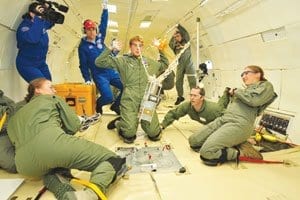“The larger the optics, the better the image,”
A few Air Force Academy researchers hope to take their latest invention where few have gone before — to near-Earth orbit.
They took a major step in getting there recently, testing a new type of telescope in zero gravity. Once the telescope is deployed, in 2015, it will be the first space-based membrane telescope.
Called the photon sieve, the invention allows a larger telescope on smaller satellites, with the potential to improve image quality.
It works like this: A thin plastic membrane is used instead of the glass normally found in the optics of a telescope, allowing the telescope to be folded into a satellite’s cargo bay. Once the satellite is in orbit, it’s deployed.
“The size of the telescope is determined by the size of the cargo bay,” said Dr. Geoff McHarg, a physics professor and director of the Academy’s space physics and atmospheric research center.
“The Hubble is only the size it is because that’s what would fit inside the space shuttle. NASA would have made a larger Hubble if they would have had a larger spacecraft to launch it. Imagine if you could get larger telescopes on smaller satellites — you’d have much better images.”
McHarg and fellow physics professor Dr. Michael Dearborn have been working on the project for a couple of years. 2nd Lt. Samantha Latch and Cadet Heather Nelson have also been involved with the laboratory work.
The group created a flat membrane to replace traditional glass optics.
“The photon sieve is thin membrane — much like plastic wrap used in a kitchen — with billions of tiny holes, each of which causes diffraction,” he said. “The holes are cleverly arranged to add up correctly to make an image. The photon sieve can be rolled delicately into a small space and stowed into a little spacecraft. “
The project has several practical applications for the Department of Defense and NASA. A larger telescope can provide better images of the earth, planets and the sun, McHarg said.
“The larger the optics, the better the image,” he said. “The photon sieve allows for larger optics, but on smaller satellites. And it’s less expensive to launch a smaller satellite — about $50,000 a kilogram.”
via Colorado Springs Business Journal – Amy Gillentine
The Latest Streaming News: Photon sieve updated minute-by-minute
Bookmark this page and come back often
Latest NEWS
Latest VIDEO








